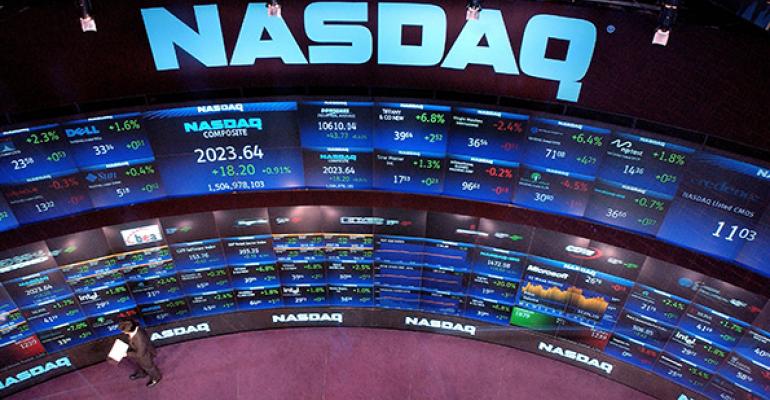(Bloomberg) -- Just outside Atlanta, a 60-year-old wealth adviser says he’s figured out how to “remove the emotion from the investing process.” How? By stuffing his mutual funds with ETFs that use leverage to amp up the daily returns of the Nasdaq 100, while using quantitative tactics to figure out when to dart in and out of the market.
Lately this unconventional approach, in the otherwise staid world of long-only asset management, has been working. Vance Howard’s HCM Tactical Growth Fund has beaten 96% of its peers over the last five years with an annualized gain of 20%.
Established a decade ago, the $1.6 billion fund currently stashes a third of its money in double- and triple-leveraged exchange-traded funds — products often favored by day traders — and spreads the rest among various megacap companies.
Finding ways to one-up the massive returns of stock indexes has become a fixation on Wall Street, as the relentless bull market leaves a slew of active stock managers in the dust.
For Howard — founder of Howard Capital Management in Roswell, Georgia — it’s been a route to expansion. Assets under management have swelled from $350 million to $6 billion in the last decade, thanks to returns that have outpaced even the S&P 500 during its big bull run.
His high-octane approach stands out, reflecting a disdain for custom and a tolerance for losses. Out of 3,153 actively run equity mutual funds tracked by Bloomberg Intelligence’s David Cohne, Howard’s shop is one of only two to list the triple-levered Nasdaq ETFs among its holdings.
“I don’t think these are high risk. My personal account is our largest client,” Howard said. “They don’t hire us to be average. If you want average, go buy an index.”
Another Howard fund, created in 2015, focuses on dividend growth. The $1.6 billion HCM Dividend Sector Plus Fund holds the same double-leveraged Nasdaq 100 ETF and a triple-leveraged S&P 500 product, which make up almost 40% of its total portfolio. It’s beaten the S&P 500 total return index in the past five years as well.
Still the strategy is not without risks, says BI’s Cohne.
“Indirect exposure to leveraged ETFs, especially triple leveraged ETFs, could expose retail mutual fund investors to large potential losses,” he said. “Doing so could be playing with fire.”
As Howard tells it, the holdings are kept honest in part thanks to computers using a proprietary “mathematically driven process” to time the market based on price trends and other inputs. He cites the pandemic as an example, when all four of his funds were allocated around two-thirds in cash, unlike most Wall Street pros who typically have a mandate of staying fully invested.
“We don’t have a set time on when we rebalance,” he added. “We are very active. We can pull out in 10 minutes. We are out in 10 minutes and we will be in cash.”
Howard’s funds have performed a bit better than the S&P 500 since inception, despite deviations during sharp market moves. In 2022, his tactical growth fund slumped nearly 40%, more than double the nearly 18% drop of the S&P 500 total return index. His dividend sector fund also tumbled around 22%.
Leveraged ETFs, which use derivatives to boost returns or even pay out the opposite of some stock or index’s return, have soared in popularity over the past year, mostly among risk-addicted retail investors.
Usually sold as tools for quick market flyers, inverse and leveraged ETFs have amassed over $8.4 billion of inflows so far, on track to surpass last year’s $10.1 billion, according to data compiled by Bloomberg Intelligence. Demand for such funds has increased as money managers seek new vehicles to bet on the market’s biggest themes like going long Big Tech. But they come with heightened risks, given that can swiftly generate losses as much as they can see gains.
“They generally are not designed for a long-term buy-and-hold strategy,” said Amrita Nandakumar, president at Vident Asset Management. “Where we see people have issues is when they lack an understanding of the fund’s leverage mechanism, and then they are surprised by unpredictable return patterns and quickly compounding losses.”
For Howard, his funds’ outperformance comes at a time when US markets are at all-time highs with animal spirits running wild. The S&P 500 smashed its own record more than 30 times this year alone, driven by the strength of a handful of stocks fueled by the frenzy surrounding artificial intelligence.
In the event that stocks go south, Howard — a four-time Texas city council member and two-time mayor pro tem — isn’t particularly concerned. He has trusted his models for nearly three decades. Since founding his firm in 1999, Howard has expanded his business to separately managed accounts, four mutual funds, and three ETFs, two of which lead Morningstar Inc.’s rankings of the best performers among stock ETFs for the second quarter.
“I am not trying to call the top or bottom of the market,” he said. “I am just trying to miss 80% of the bad and capture 80% of the good.”





